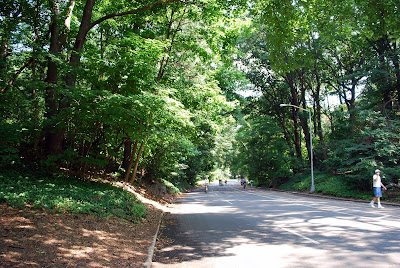All photos can be enlarged by clicking on them
The Battle Of Brooklyn was the largest battle ever fought in North America up to that point in history, and it ended in a crushing defeat for the American Continental Army. Outnumbered and overwhelmed by the better equipped, more professional British and mercenary Hessian forces, the Americans suffered great casualties, and many soldiers and patriot civilians were taken, prisoner. The remaining 9,000 Continental Army forces in Brooklyn were congregated within a three-mile area in northern Brooklyn near the East River in the neighborhood known as Brooklyn Heights. They faced certain annihilation after the battle that took place at The Old Stone House (see part two) except for the fact that torrential rains began to fall, along with high winds and lightning, which prevented further fighting. British General Howe decided to have his troops dig trenches and hold fast, and they began hauling 25-pound cannons up the roads to get ready for the next siege.
Fortuitously, the stormy weather also prevented the British fleet from sailing up the East River, because almost the entire American army could have then been surrounded and destroyed. It would very likely have been the end of the American Revolution.
For the next two days, America General George Washington and his army expected a British assault, and Washington even believed at first, after witnessing the bravery of the Maryland 400 at the Old Stone House that his troops could hold back the British, but the weather continued to deteriorate in what was probably a Nor'Easter storm and it became evident he was in danger of being cut off entirely from Manhattan and the rest of his troops. On August 29th Washington meets in a house in Brooklyn Heights with his subordinates, and after receiving their grim reports of hungry, wet and demoralized troops, and the continued progress the British were making on advancing their cannons, Washington decided to make the momentous decision to retreat from Brooklyn to Manhattan.
General Washington sent out an order that every flat bottomed boat or sloop, any watercraft at all, be rounded up without delay. About 9 PM in the evening the American troops with the least experience, along with the sick and wounded, were sent to Brooklyn Ferry landing under the pretext that they were being relieved by other troops. Washington wanted the entire retreat to be as secret as possible and did not even inform some of his officers.

To move such a large body of troops, with all their equipment across a river a full mile wide with a rapid current during a storm, appeared a formidable task. At eleven o'clock, however, the northeast wind died down, and a small armada of boats manned by Colonel John Glover's Massachusetts troops, which consisted of seasoned sailors and fishermen, started to ferry the rest of the troops silently as possible in the dark of night across the river.
 Fulton Ferry Landing, Brooklyn, New York--the point where George Washington and the troops crossed the east River--click to enlarge
Fulton Ferry Landing, Brooklyn, New York--the point where George Washington and the troops crossed the east River--click to enlargeIt was a tremendous feat, manning the oars, moving troops and horses and cannons for hours upon hours. The troops were kept silent and they were even instructed not to cough! Holding the line for the Americans was Brigadier General Thomas Mifflin and the Pennsylvania brigade. They kept the campfires burning and created a stir to keep the British Army from discovering that the American troops were slowly retreating across the river throughout the night.

As morning approached, there were still many troops waiting to be brought across the river, and without the cover of night, the chance was that the retreat would soon be discovered by the British. Incredibly, just before daybreak, a heavy fog settled over Brooklyn while over on the Manhattan side of the river there was no fog at all. At around 7AM all 9,000 troops had escaped across the river with General Washington on one of the last boats to leave. Not one life was lost, and only three men who secretively remained behind to loot were captured.

A commemorative marker at the Fulton Ferry site--click on to enlarge
 A view of Brooklyn from Manhattan --enlarge the photo to see Fulton Landing located in front to the small white building near the right of the Brooklyn Bridge
A view of Brooklyn from Manhattan --enlarge the photo to see Fulton Landing located in front to the small white building near the right of the Brooklyn Bridge
The British realized on the morning of August 30 that, to their astonishment, while they slept the entire American Continental Army had retreated across the river. With the British again in pursuit, Washington moved his headquarters to Washington Heights in Manhattan, and after the Battle of Harlem Heights in September and the fall of Fort Washington in Washington Heights on Nov. 15, all of what is now New York City was in British hands and remained so for the rest of the war.
The story does not end here. Thousands of troops and civilian patriots had been taken prisoner during The Battle Of Brooklyn, and in other battles, in Manhattan, and in my next blog post I will tell you what happened to them and show you their poignant memorial, called The Prison Ship Martyrs Monument--click here to see that post.

































































